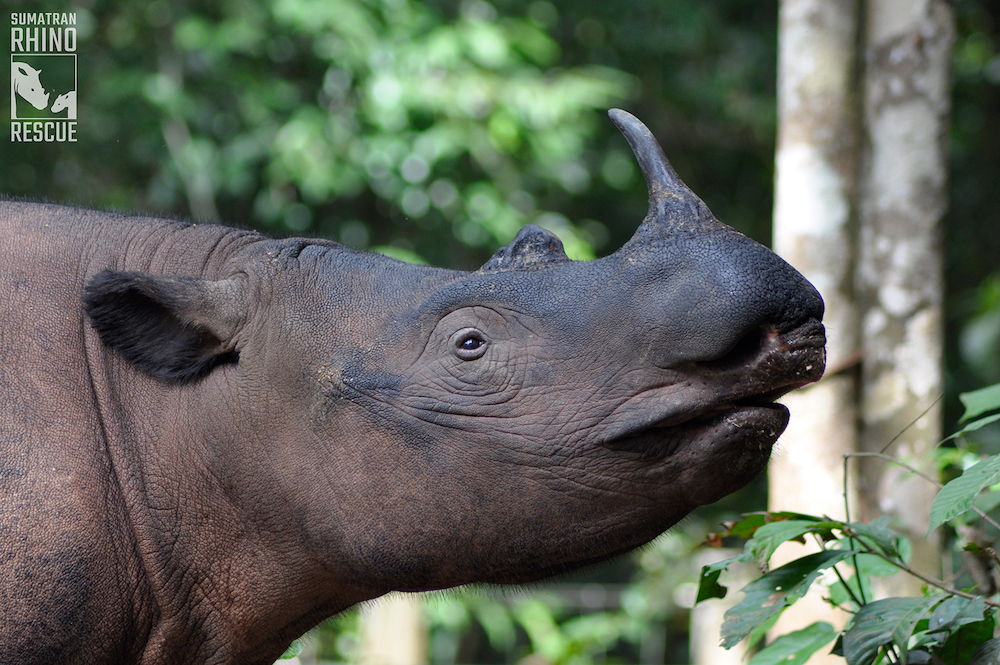You desperately need to find your keys, but they have somehow gone into hiding. We’ve all been there. You know they must be at home, so you start the search, looking through every nook and cranny, rifling through draws, cupboards and cabinets. If your home was the size of a rainforest, you can imagine how much longer it would take (and how much harder it might be) to comb through every inch of a dense, humid jungle! That’s what it feels like searching for Sumatran rhinos.
Thanks to intense monitoring and research, we know that the remaining animals (there are fewer than 80 on the planet) reside in a few small populations across the rich rainforests of Sumatra and Borneo. Unfortunately, that doesn’t make it any easier to track them down, but this process is crucially important. Sumatran rhinos are at extremely high risk of extinction, because they’re so isolated, that they struggle to find a mate and breed successfully. They live in such remote locations, that it can take 15-20 days for search teams to reach a habitat that might be home to rhinos. Once they get to the right area, specialist four-person units spend their days looking for twisted branches, unique footprints and piles of rhino dung: the tell-tale signs of a Sumatran rhino.
Finding any trace of a rhino sparks months of intense tracking and monitoring. Over this time, we learn more about the places it likes to visit, where it enjoys wallows and where the best salt licks are found. Camera traps will be set to find out the rhino’s sex, age group, and health condition. As much information as possible is gathered so that plans can be made for the next phase: rescuing the rhino and moving it to a Sumatran Rhino Sanctuary.
Safely capturing the rhino is extremely difficult. First, teams dig a huge pit, 12 ft long, 4 ft wide and about 6 ft deep. And then, they wait. It can be weeks, if not months, until the rhino is caught. The pit trap is checked every day, and the team remains on-hand at a nearby camp, ready for their rescue mission.
Once caught, the rhino is carefully monitored before, during and after the move to a rhino sanctuary. There, the rhino will slowly settle into its new semi-wild home, with expert round-the-clock care making sure that the new rhino, and all others already calling the Sanctuary home, stay healthy, in the hope that they can bring new calves into the world.
One special population of Sumatran rhinos live at the Sumatran Rhino Sanctuary (SRS) in Way Kambas National Park, Sumatra. There are seven resident rhinos at the SRS, two of which were born at the Sanctuary in 2012 and 2016. Delilah, born in 2016, recently transitioned from staying with her mother to her own enclosure. Since Delilah has gained more independence, her parents, Ratu and Andalas, have started to mate again. Hopefully it won’t be too long before the pair welcome their third calf!
Of course, searching for Sumatran rhinos, rescuing isolated animals and helping them to breed successfully is not possible without substantial funding. Since 2018, we’ve sent more than £100,000 to support all of this work, joining up with an international group of NGOs to save the Sumatran rhino from extinction. Thanks to donations from you and our partners, including Wilhelma Zoological and Botanical Garden, Stuttgart, the SRS has been able to double in size in the past year, making room for more rescued rhinos, and the veterinary lab at the Sanctuary has been upgraded, so that every rhino receives the very best care.
Through this dedicated work and continued support, we’re hopeful that more Sumatran rhinos will be born, and the species will be able to recover, growing towards a healthy, thriving population.









